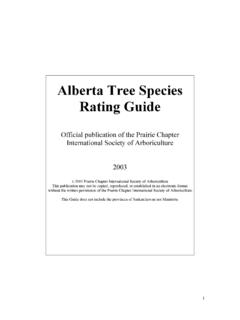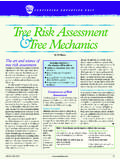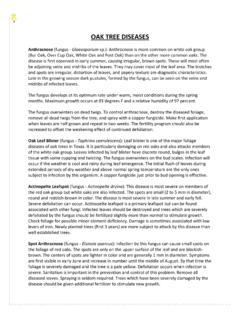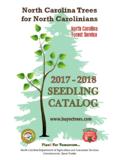Transcription of Guide to the Common Native Trees and Shrubs of Alberta
1 Guide to the Common Native Trees and Shrubs of Alberta Guide to the Common Native Trees and Shrubs of Alberta By Wayne Inkpen and Rob Van Eyk To order please contact: E: Tel: (780) 421 1497. Table of Contents Page Preface .. 1. Acknowledgements.. 1. Introduction.. 2. Illustrated Glossary of Terms.. 4. How to Use the Key .. 8. Key .. 9. Plant Descriptions.. 22. Table Importance of Shrubs to Wildlife .. 51. Bibliography .. 52. Index of Common and Scientific Names .. 54. 1. Preface There are several references on plant identification available to Albertans. However, these publications are generally not suited for field use. This Guide has been prepared to assist vegetation managers in the identification of the 29 most Common woody plants found in Alberta .
2 It is hoped that the knowledge thus gained will assist vegetation management per- sonnel and pesticide applicators to make sound vegetation and management decisions and provide recreationalists with additional enjoyment when they are in Alberta 's woodlands. One does not require a background in forestry or botany to use this Guide . A minimal number of technical terms have been used and an illustrated glossary has been included to allay any difficulties the user may have with botanical terms. To aid identification, a written description of each tree and shrub has been included, along with photographs and an illustrated line key based on leaf characteristics.
3 Where applicable, species with similar characteristics have been noted in the narrative descriptions. Instructions on how to use the illustrated line key are included, along with a table listing the importance of the various Shrubs to wildlife, and a selected reference list for those interested in more detailed information. Acknowledgements Among the many people involved in the preparation of this Guide , special thanks are due to the following for their noteworthy contributions: Mr. M. Allen for his line key and technical review; Mrs. J. Hrapko and Mr. D. Blackmore for their constructive suggestions, photographs and technical review; Mr.
4 R. Vic and Dr. B. Dancik for their constructive suggestions and technical review; Mr. H. Anderson, Mr. D. Johnson and Mr. D. Pledger for their constructive suggestions and Mrs. H. Inkpen for the charts and illustrations. 2. Introduction There are 12 major vegetation types in Alberta . Within each of these types one or more of the Trees and Shrubs listed in this Guide can be found. The narrative descriptions of the woody plants included in this Guide follow a systematic order which is in accordance with the classification system used by botanists. Each description is headed by the tree or shrub's Common name and scientific name. The scientific names are in Latin and usually comprise two words.
5 The first word is the generic name and the second word is the species name. The last part of the scientific name usually refers to the individual who named the plant. Scientific names were included because a tree or shrub can have one or more Common names. For example, Populus tremuloides Michx. is known as aspen poplar, trembling aspen and white poplar. Because Common names can be localized and vary from region to region the scientific name is the only name that precisely identifies a plant. Following a plant's Common and scientific names, a brief description of the plant's shape, size, leaves, flowers, fruit and distribution has been included.
6 Based on the characteristics of their leaves, the Trees in this Guide can be split into one of two groups: coniferous Trees and deciduous Trees . All of the Shrubs in this Guide are deciduous Shrubs . Coniferous Trees are commonly referred to as evergreens, softwoods or needle- leaved Trees , and with the exception of tamarack, all of the Trees in this group retain their leaves for two or more years. The deciduous Trees and Shrubs are most often referred to as broadleaf Trees or Shrubs . Deciduous Trees are known as hardwoods. All of the Trees and Shrubs that fall into this group drop their leaves in the autumn. 3. 4. 5. 6. 7. 8. How To Use The Key The key is an aid to help you identify the most commonly occurring woody Shrubs and young sapling-size Trees in Alberta on the basis of summer characteristics.
7 In some cases, other obvious features such as bark colour and texture, are also mentioned. On the next page is a master key outlining the organization of the main identifying features using a branching network of two contrasting features. The following steps will show you how to get the most use out of the key: STEP 1: Start at the top of the chart (page 9) at the TYPE OF LEAF, and then work progres- sively down the page. You should work with at least three leaf samples taken from various parts of the plant. STEP 2: Since Trees and woody Shrubs in Alberta have either a BROADLEAF character or a NEEDLE LEAF character, this step organizes all the Common plants into two groups.
8 STEP 3: The illustrations beside each feature will Guide you as to the meaning of the features used. If in doubt about a word meaning, see page 4, the ILLUSTRATED GLOSSARY. OF TERMS. STEP 4: Once you have worked your way through the chart on page 9, you will have noticed a page number beneath the last feature in that particular branch of the key. Go to that page in the text and you should see several possibilities as to the identity of the plant. You will also notice that the step-by-step feature identification which you used in the chart on page 9 is reproduced for that particular branch of the key. STEP 5: Finally you are left to choose among several possibilities as to the exact name of the plant you are identifying.
9 Read over each description, and determine which one best fits the plant you have. 9. 10. 11. 12. 13. 14. 15. 16. 17. 18. 19. 20. 21. 22. Jack Pine Pinus banksiana Lamb. Photo by J. Hrapko Photo by J. Hrapko tree : Small shrubby conifer on open sites, somewhat taller in dense stands. Bark reddish-brown with irregular scaly ridges. Lower branches wide spreading. SIZE: 5-20 m high; trunk 20-30 cm diameter. LEAVES: Needle-shaped, in bundles of two, generally diver- gent, 2-5 cm, yellowish green. CONES: Conical, 3-5 cm long, strongly incurved, generally in pairs, directed toward the tip of the branch, without prickles. DISTRIBUTION: Common on sandy and gravelly sites in central and northern Alberta .
10 NOTES: Lodgepole Pine (P. contorta var. latifolia) and Jack Pine hybridize freely where the ranges of these two species overlap in central Alberta . 23. Lodgepole Pine Pinus contorta var. latifolia Loudon. tree : Tall, slender conifer, with little taper and straight trunk. Bark orange-brown, some- what scaly, less than 2 cm thick. Branches curve upwards; self pruning in pure stands. SIZE: 20-30 m high; trunk 30-45 cm in diameter. LEAVES: Needle-shaped, in bundles of two, 2 1/2 -8 cm long, spirally twisted, stiff, very sharp pointed, yellowish-green; form dense clus- ters toward the ends of twigs. CONES: Short-cylindrical to egg-shaped, curved away from branch tip, 2-5 cm long, remain on Trees for many years; scales armed with small prickles.







